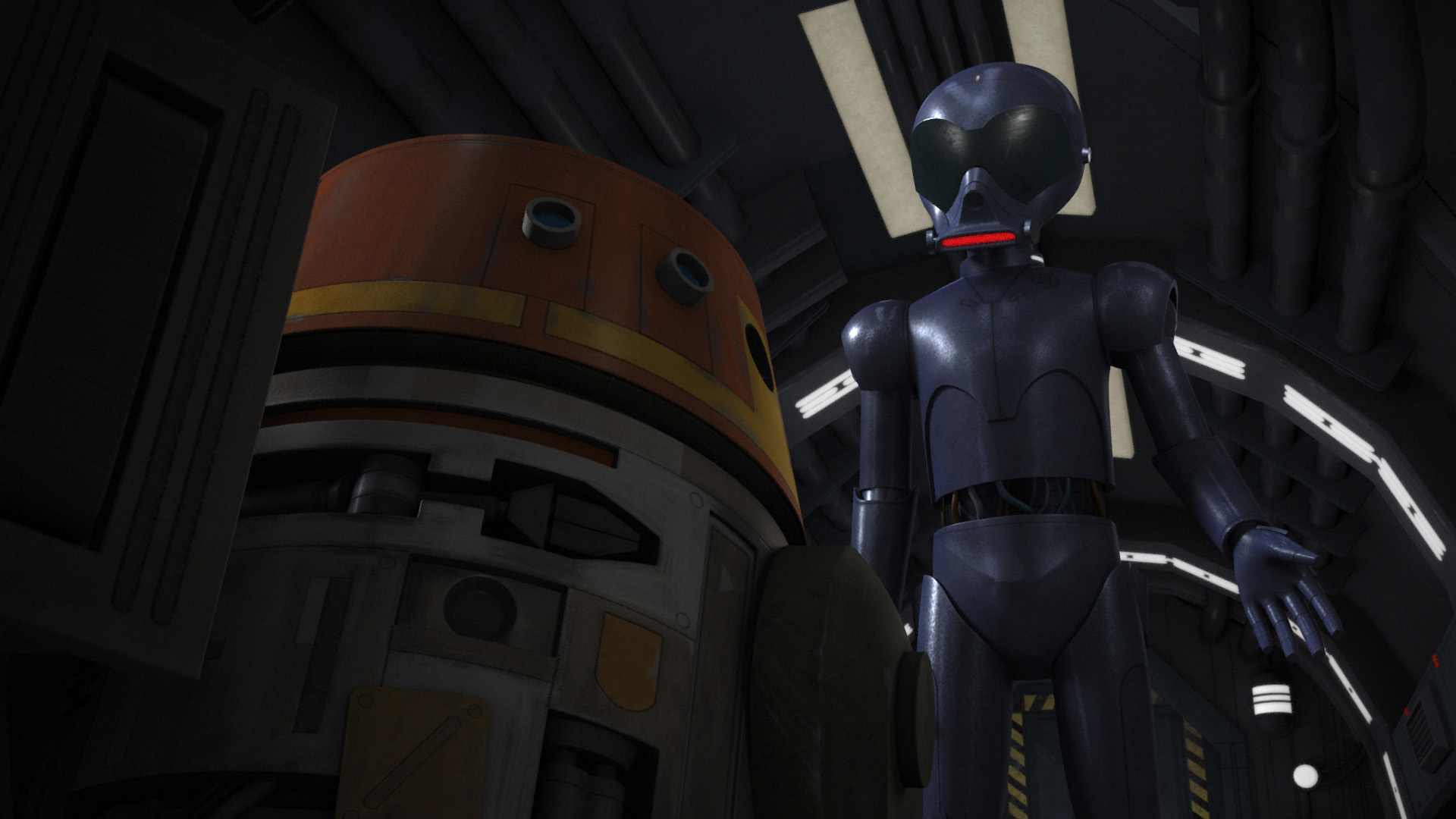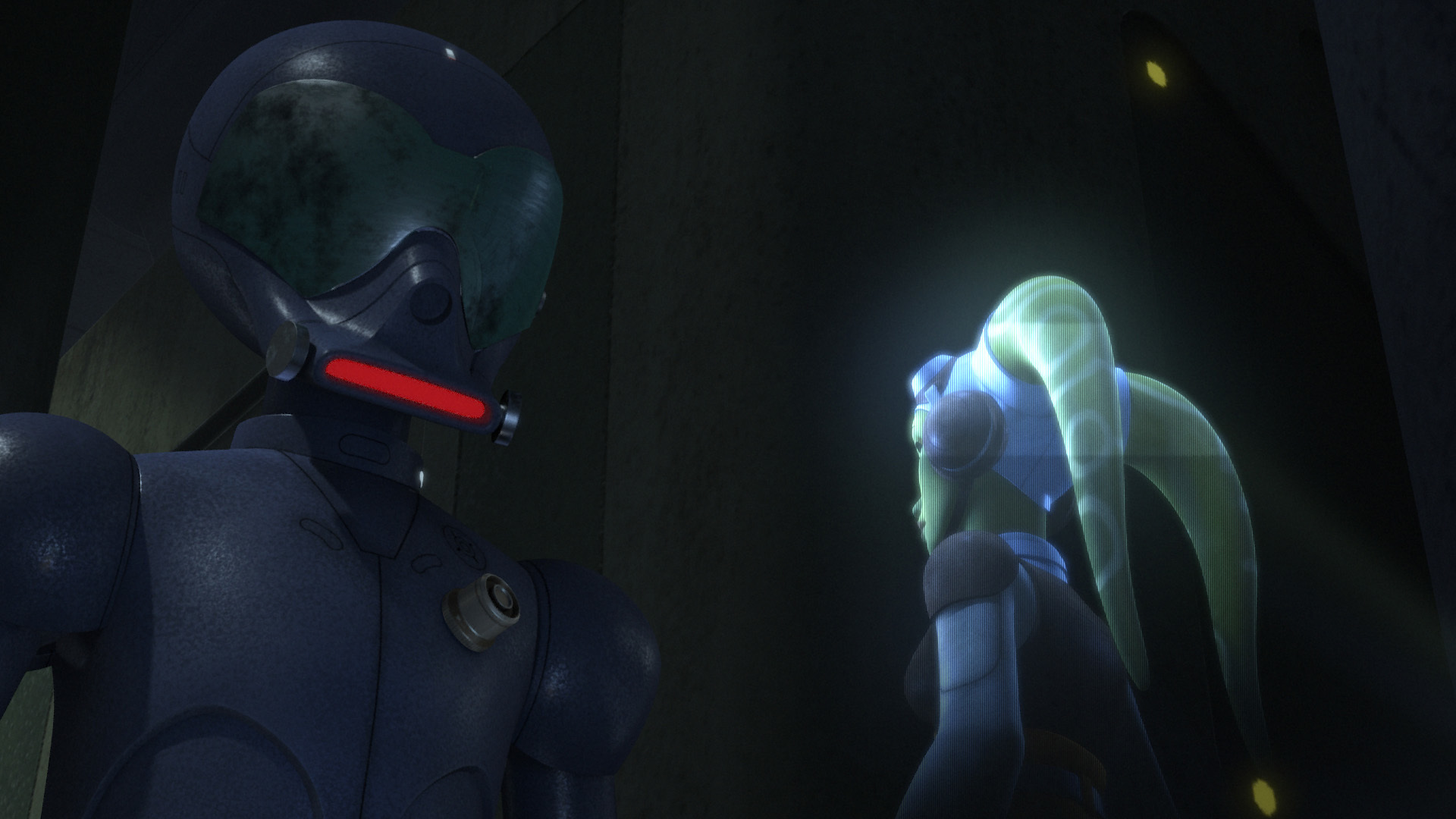Greetings, fellow human! Note that this is not a full review. If you like that, cool, but here we take a look at a couple of aspects of each episode and discuss them. Best read after having watched the episode, and as always SPOILERS from here on out.
In this episode of Rebels, entitled The Forgotten Droid, Chopper gets a fwiend. And indeed that’s pretty much the only thing that happens and thus the only selling point. As I demonstrated to my not-a-Star-Wars-fan sister. Over and over again. I made it her special hell.

Building
The benefits of telling a story in a TV show instead of a film is that you’re allowed to do so much more and do it in vastly different ways. The purpose of this show, as I understand it, is to demonstrate how the rebellion came to be. This usually takes the form of showing our Spectres fighting small scale battles against the Empire, or demonstrating said Empire to be cruel and ruthless and thus making it worthwhile to overthrow them, or highlighting how various people came to be a part of the rebellion. But there is another way – one that is quite important but not quite as flashy, and when done right is done subtly. It’s also something that many role-playing gamers may know well: resource building. This is the gradual accumulation of resources through various means. Sometimes it’s as simple as ‘Press Enter to accept Cmdr Millicent into your team’ – the most common of recruitment drives known to military the world over (I assume). Sometimes it’s stealing supplies or ships so that you have an armada with which to advance ‘The Cause’, and certainly you may recall one of the previous episodes where the rebels captured the ship carrier that played such a central role in this episode. That was one of the more obvious examples of resource building (or RB for short).
RB is an absolutely necessary component to this kind of show, and the kind of story it’s trying to tell. As Zarm, a regular commenter on this website (hi Zarm!), made mention several weeks ago in the comments, Phoenix Squadron has a … let’s call it a quick turnaround. They frequently experience losses of manpower and resources – and simply showing that, week after week, does strain viewer credulity. But by indulging in RB, by demonstrating where those pilots and those A Wings come from, lends weight to their use in action scenes. They’re no longer Redshirts, or background objects to make the action seem tense, but actual beings whose presence has narrative importance. And those A Wings are no longer cheap bits of machinery that are easily replaced (that is to say, they may be, but I wouldn’t know), but that they’re valuable resources that the Rebellion has struggled hard to acquire, so that the loss of a single snubfighter has the potential to severely impact the Rebellion’s fighting strength. To briefly give a historical example, we saw this during the Second World War, during the Battle of Britain. Daily the Luftwaffe would send wave upon wave of fighter planes to harass military bases, damage industrial and civilian areas and in general be a nuisance. They had hundreds, if not thousands, of aeroplanes at their disposal – but the continual loss of planes or pilots was not something they could afford or sustain. Compare that to British and Allied pilots who, if shot down, could return to work the next day – simply because they had been shot down above friendly territory whereas if the Luftwaffe were to be shot down then they could expect a lengthy stay in a POW camp. And beyond that, these Allied pilots could fly in new planes supplied by the ATA. Their shot-down vehicles, too, would be salvaged and reused – if not as planes then as something else of value to the war effort.
By now you may have spotted something wrong with my line of thinking, and don’t worry, that’s on purpose*. This episode wasn’t about A Wings or Phoenix Squadron. It was about AP-5, the eponymous forgotten droid (yeah I said it, fight me), as well his supply ship joining the Rebellion, swelling its ranks with another ship, but more importantly the presence of AP-5 provides the Rebellion with much needed insider intel as well as a useful tactical mind. It was a great way of introducing what could potentially be a key asset to the Rebellion – and it was also done in a fairly subtle way.
*Mostly
It’s perhaps unkind but true to state that this show has not, on many an occasion, been the most subtle in its storytelling. Probably most viewers could spot a mile away any plot twist or character development before it had time to take full form (as evidenced by the return of Ketsu Onyo as she aided the Rebellion. I’m sure many called that she would come to aid the rebels).

Speaking of subtlety, if I may be forgiven for drawing a negative comparison (I loathe to do this, usually because it’s often tacky and unecessary), I’d like to draw your attention to another show: Star Trek.

Star Trek: Voyager was rather notorious by utilising a form of RB. For those unfamiliar with the show, the premise was that the starship Voyager was, via a Deus Ex Machina device known as The Caretaker, flung to the other side of the galaxy, and it was the job of the crew to make the 70,000 light-year journey home. This sounded good – until you realised that at the end of every other episode saw one crew member or another say ‘this new technology ought to take a few years off our journey’. It was about as subtle in its resource building as Zeb in a gun factory. Rebels has a similar task at hand: it must build the Rebellion up into something that looks capable of taking on an entire fleet at the end of Return of the Jedi. And, like Voyager, it must also do quite a large amount of RB on a near weekly basis.
But unlike Voyager it occasionally takes great pains to hide this fact, usually by making them into character-centric episodes. In the past we’ve had episodes like the B Wing episode, or the Ryloth episode, where the gaining of new technology was obviously the goal from the start, but the focus was almost entirely on its characters. In the former, we explored Hera’s back-story and her love of flying. In the latter, Hera had to overcome her backstabbing, traitorous father* in order gain a base of operations for her squadron. But Forgotten Droid surpasses these attempts, because once again the narrative focus is not on the need for supplies (this quite literally takes place in the background), but Chopper and AP-5. It’s through a heart-warming sharing of character background that key information is dropped, like Chopper’s military experience and Apey’s tactical expertise. And later we’re shown that AP-5, a lowly navigator droid, knows that the Rebels’ safe port is in fact a trap. How he knows is not explained – but for now that’s not important. What is important is that he knows. These scenes are brief blink and you’ll miss it moments, but ones that delivers possibly vital information.
*Not bitter at all. Honest.

But this does come with negatives. Earlier I made a point of the necessity of demonstrating where Phoenix Squadrons gets its pilots and war materiel. I made this particular example because it focuses on the events and people in the show itself (see, I wasn’t losing it!*). As things are, Rebels tends to focus its world- and resource-building for the benefit of the movies rather than for the show itself. This is understandable – particularly as we once had an expanded universe that gave us back-stories on a number of characters who were seen for a whole two seconds on screen. Again it’s understandable and to a degree I accept this as both necessary and good. But at the same time, especially in the case of RB, I do feel that the show could do better by focusing on building up its own resources. This is mainly because the series itself has, in the second series alone, greatly expanded its scope, so that it could be thought of as a universe in its own right – and one that doesn’t really need to feed another universe, or even feed off it. (I’m terrible at metaphors, so for clarity the other universe I’m mentioning is the movie universe).
*Well, I am, but not that time.
It’s a young show so of course it needs to learn on its big brothers and sisters (to haphazardly mix metaphors), but it’s quickly moving beyond that necessary crutch to a point where it can stand on its own two feet, and at that point it ought to learn away from RBing for the movies and just concentrate on itself.
P.S. I suck at metaphors.
Author: Michael Dare
Michael Dare is a writer, lives in the UK, and has been slowly coming to terms with the realization that he is not Sherlock, but Watson. He loves Star Wars, dislikes blue milk. Enjoys jumping sharks. Survives on the tears of sexist men, and cheeseburgers.

Hi Michael! You made my day!
Not much to add; you brought out more affection for this episode than I could muster for it. 🙂 When your referenced Voyager, I realy thought you were going to compare the constantly-lost and magically replenished shuttlecraft (and photon torpedoes) to Phoenix Squadron. 😉
Hi Zarm, I’m glad to hear it!
It’s funny you should mention the shuttlecrafts, because I was thinking about including a little reference to that! But I didn’t want to push my luck by having too many Star Trek references in a single review, haha.
M
Well, I’m one of the few people on Earth that thinks you can never have to many references to Voyager… 😉 But I see your point. 🙂
*Fist bump*
M